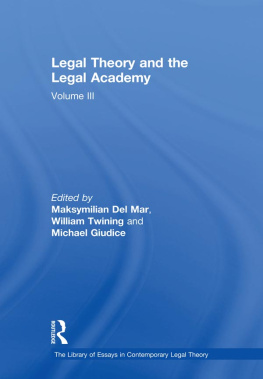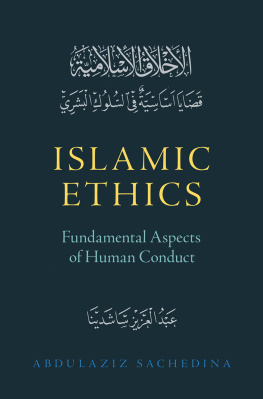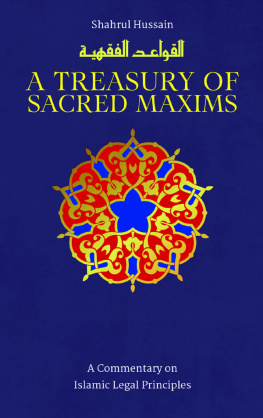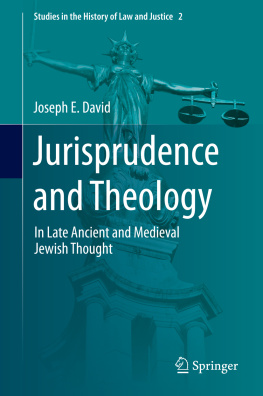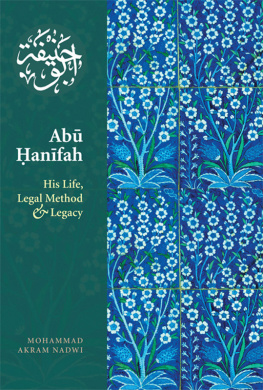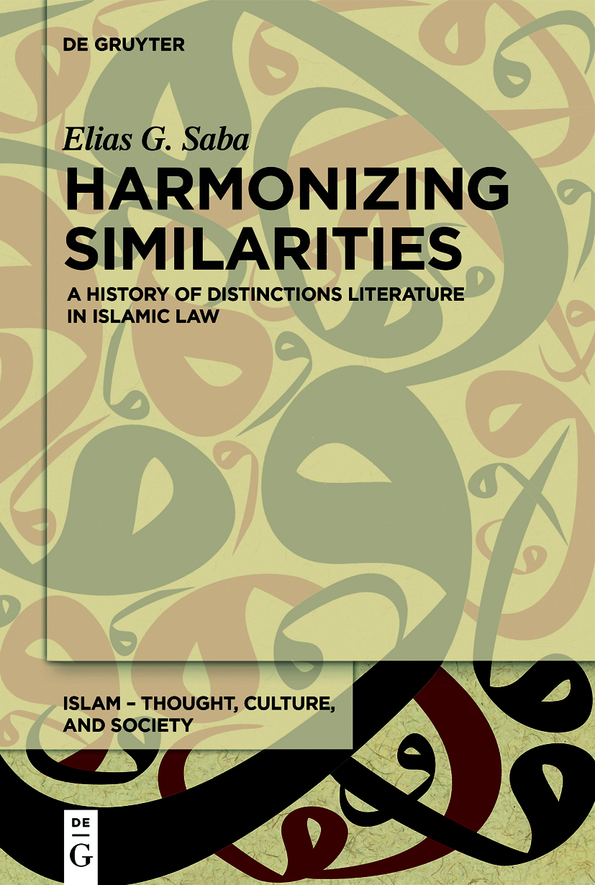Islam Thought, Culture, and Society
Volume
ISBN 9783110604054
e-ISBN (PDF) 9783110605792
e-ISBN (EPUB) 9783110604399
Bibliographic information published by the Deutsche Nationalbibliothek
The Deutsche Nationalbibliothek lists this publication in the Deutsche Nationalbibliografie; detailed bibliographic data are available on the Internet at http://dnb.dnb.de.
2019 Walter de Gruyter GmbH, Berlin/Boston
Acknowledgements
This book is the fruit of years of intellectual labor. I have been fortunate to have had the help, guidance, and friendship of a great many people and institutions. This book is a refined and improved version of my dissertation. Paul M. Cobb and Jamal J. Elias provided exceptional help and mentoring during my graduate studies, as I wrote my dissertation, and having continued to do so in the following years. My dissertation advisor, Joseph E. Lowry, was an exemplary advisor. He provided constant encouragement and detailed critique.
This study would not have been possible without the help of a variety of grants. The Mellon-Mays Fellowship has provided years of financial support and provided me with a community that has been key to my academic success. I am also grateful for a residency at the American Center for Oriental Research through an ACOR-CAORC grant during which I was able to conduct much of the research that guided this book. At the University of Pennsylvania, I was able to succeed thanks to a Benjamin Franklin Fellowship, the Foreign Language and Area Studies Fellowship, a fellowship from the Communication within the Curriculum program, a Janet Lee Stevens Fellowship, and a grant from the Digital Humanities Forum.
I am grateful to the BRAIS De Gruyter Prize 2018 committee for honoring my work. As I have refined this monograph, I have benefitted greatly from the help of Robert Gleave and A. Kevin Reinhart. Marc Herman and Nicolai Sinai provided wonderfully detailed feedback on the majority of this book. I also wish to thank Sophie Wagenhofer, Katrin Mittmann, and Andr Horn at De Gruyter for all of their editorial assistance.
I am grateful as well to those who have read sections of this work and/or have helped me refine my arguments. In particular, I thank al Ab al-jj, Roger M. A. Allen, Jeffery Arsenault, Kameliya Atanasova, Carolyn Baugh, Joel Blecher, Carolyn Brunelle, Talya Fishman, Angela Giordani, Ari Gordon, Cameron Hu, Ali Karjoo-Ravary, Nicholas Harris, Renata Holod, Murad Idris, Matt Keegan, Susan MacDougall, Christian Mauder, Christian Mller, Tilman Neuschild, David S. Powers, Raha Rafii, Yossef Rapoport, Ryan Rittenberg, Noel Rivera, Mariam Sheibani, Thomas Levi Thompson, and Amir Toft. I also wish to thank my colleagues at Grinnell College for their help and encouragement. In particular, I wish to thank Shanna Benjamin, Caleb Elfenbein, and Karla Erickson.
I also thank the helpful and accommodating staffs at the British Library, the Bibliothque nationale de France, the Staatsbibliothek zu Berlin, the Suleymaniye Library in Istanbul, the Leiden University Libraries, the Garrett Library at Princeton University, and the staff at the New York Public Library, particularly Thomas Lannon.
Finally, I thank Eiren Shea for unwavering emotional, intellectual, and editorial help during every stage of this book.
Introduction
What is the social history of Islamic legal literature? The answer to this question remains unclear. Even though the history and development of Islamic law have long formed the subject of extensive scholarly study, scholars have not discussed the rhetoric or aesthetics of laws literature. Most of the study of Islamic law has tended to focus on the legal system that is described in works of Islamic law, at the expense of the way that this system is expressed. Yet, change and dynamism in Islamic law also occurs through the ways in which legal knowledge is packaged, organized, and presented; in other words, through development and change in literary features, such as genre. A focus on Islamic law as a field of learning rather than as part of a legal system requires a greater focus on its literary characteristics.
Modern scholarship has generally divided the history of Islamic law into three periods: early, middle, and modern. Most scholars have focused on the rise and early development of the Islamic legal tradition or the transition to multiple modern, national ones that selectively incorporate concepts from Islamic law. This division parallels the prevailing periodization of the history of Islamic societies generally. Marshall Hodgson divided that history into three broad periods, which he labeled the Classical Age, the Middle Periods, and Gunpowder Empires and Modern Time. This lack of scholarly attention is due to a belief that this period was one of legal and cultural stagnation. The scholars who do study this period, however, have shown that Islamic law underwent remarkable changes.
The misunderstanding about a so-called middle period of Islamic law relates, at least in part, to a misconception about the very nature of Islamic legal change. In arguments about development or lack thereof, scholars have attempted to look for changes or development in either the substantive rules of Islamic law (fur al-fiqh) or in legal theory (ul al-fiqh). Since Islamic law is understood as a legal system, it makes sense to look for development to occur in manuals of substantive laws or in the theoretical writings on legal interpretation. Fur al-fiqh and ul al-fiqh are not the two halves of Islamic law, however; they are only two genres of Islamic legal literature. In addition, Islamic law can also be understood as a scholarly discipline, concerned with the production and organization of a specific kind of knowledge. According to this understanding, promulgation of new substantive rules and advancements in legal theory are only two possible kinds of development.
This book traces the history of one understudied genre, that of legal distinctions, al-furq al-fiqhiyyathe comparison of apparently similar fact-patterns that lead to different legal outcomes. Examining thirty-six works that belong to this genre, composed over a period of approximately six hundred years, allows us to understand the social and intellectual trends that drove the rhetoric of this genre. The beginnings of this genre can confidently be dated to the fourth/tenth century, though the earliest such work remains to be identified. The fifth/eleventh century saw a surge in works addressing legal distinctions, and the genre flourished in the seventh/thirteenth and eighth/fourteenth centuries. Books of legal distinctions were written in all four Sunni schools of law, although it found greatest currency in the Shfi school. In general, Shii jurists did not compose works of legal distinctions, although an early work is attributed to the Shii jurist Amad ibn Muammad al-Barq (d. third/ninth c.) and another work is attributed to the Zayd author Al ibn Yay ibn Rshid al-Washl al-Yaman (d. 777/137576). The genre seems to have been particularly popular in large urban centers, with an original point of focus in Abbasid Baghdad and later in Mamluk Cairo. The manuscripts of books of legal distinctions show that these works were copied and recopied often and circulated widely.
This study emphasizes one literary manifestation of Islamic law. In particular, it looks to expand the study of genre within Islamic legal writing by carrying out a history of one particular genre. The genre of legal distinctions has received little scholarly attention. Nevertheless, its history is an important part of the development of Islamic law. This study shows the genre to be a valuable rubric for locating the relevance of later Islamic legal literature, and in particular highlights the intellectual and social background from which this genre emerged and the specific ways in which the genre of legal distinctions adapted to changing social patterns that affected the consumption of Islamic legal knowledge.


